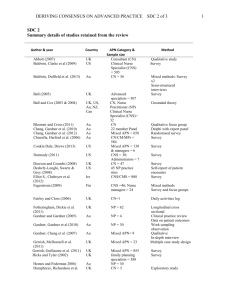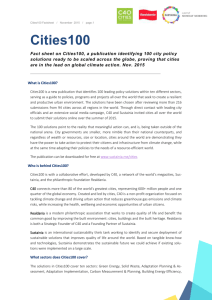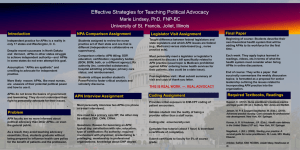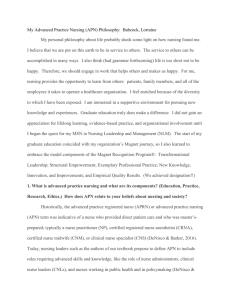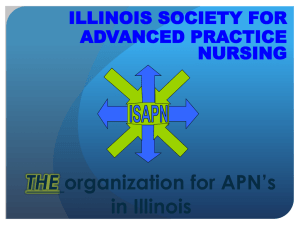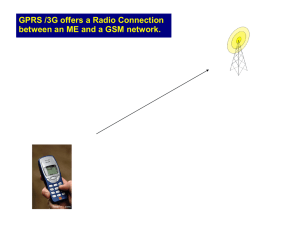does regulation of advanced nursing practice roles assist in future
advertisement
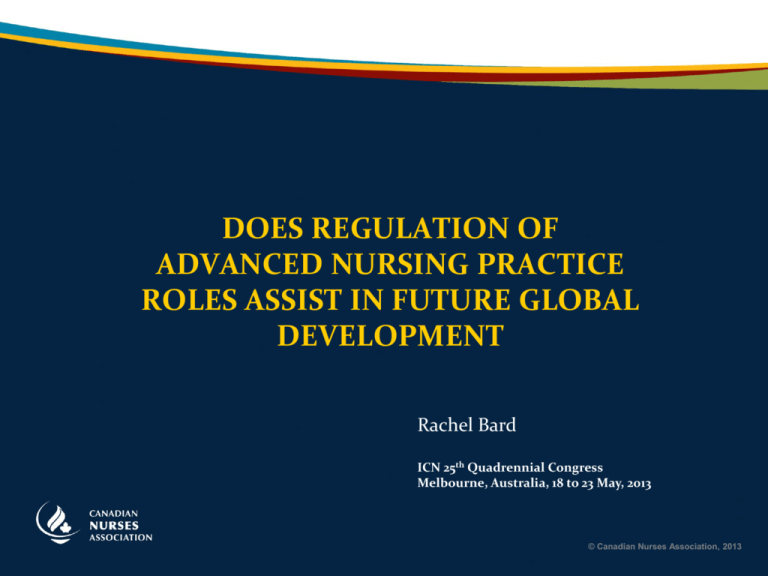
DOES REGULATION OF ADVANCED NURSING PRACTICE ROLES ASSIST IN FUTURE GLOBAL DEVELOPMENT Rachel Bard ICN 25th Quadrennial Congress Melbourne, Australia, 18 to 23 May, 2013 © Canadian Nurses Association, 2013 Outline • • • • • • • • • Introduction Methodology Demographics Regulation of roles Education Requirements to practice Scope of practice Themes Discussion Introduction • Background • INP/APNN subgroups • Pulcini et al 2010 • Regulatory Framework Advanced Practice Nurse A registered nurse who has acquired the expert knowledge base, complex decision-making skills and clinical competencies for expanded practice, the characteristics of which are shaped by the context and/or country in which s/he is credentialed to practice. A master's degree is recommended for entry level. International Council of Nurses Literature • Development of APN roles is a global trend (Bryant, 2005) • Developed to meet specific needs such as shortages in human health resources or to address emerging health needs of the population (ICN, 2008). • There is wide variation of APN scope of practice, education requirements, regulation worldwide (ICN, 2009). Background – Little opportunity for INP/APNN to focus on regulatory issues in past – Particular student interest in international APN work – Challenges globally around the regulation of APNs Background Regulation of professional practice is important. – legitimacy through credentialing – defines scope of practice, authorizes clinical tasks and entry requirements – helps to ensure safe and competent practice (Gummer, 1984; Morrison & Benton, 2010; Bryant, 2005). Methodology • • • • • International on-line survey Ethics approval Convenience sample (snowball) Invitation to ICN member countries Individual recruitment Survey Development • Coordination of information and resources: – Literature – 2007 survey by Pulcini et al – Consultations: • INP/APNN Core Steering Group • INP/APNN Education/Practice Subgroup • Health Policy Subgroup • ICN Regulatory Consultant • McMaster and Laurentian Universities, Ontario, Canada 9 Survey Categories • • • • • • General Information Types of APNs Regulation of roles Education Requirements to practice Scope of practice Countries Represented in the APN Survey (n=36) • • • • • • • • • • • • • • • • • • Angola Australia Austria Bahamas Bolivia Botswana Bulgaria Canada Congo, Democratic Republic of Finland France Gambia, The Greece Iran, Islamic Republic of Ireland, Republic of Italy Japan Lebanon • • • • • • • • • • • • • • • • • • Malaysia Mongolia Netherlands New Zealand Poland Sierra Leone Singapore Spain Sri Lanka Suriname Switzerland Taiwan Tanzania Thailand Togo Trinidad and Tobago United Kingdom United States APNs identified • • • • • • • • NP: 16 countries APN: 12 countries CNS: 18 countries NS: 15 countries Nurse midwives: 2 countries Nurse anesthetist: 2 countries Clinical nurse consultant: 1 country No APN role: 4 countries Regulation of Roles • • • • • • NPs with regulation = 8 (n=15) APN = 5 (n=11) CNS = 4 (n=14) NS = 6 (n=10) Nurse midwives = 2 (n=2) Clinical Nurse Consultant = 1; not regulated • APN roles with regulation (25) – 16 are regulated by federal legislation – 9 by individual jurisdiction – (2/3 vs. 1/3) Educational Requirements • 42 (n=52) roles identified across all the countries require a minimum level of education • Educational requirements ranged from: – – – – – post basic certificate (non-academic) baccalaureate masters post masters certificate and doctorate • 25 (N=52) require masters preparation Practice Requirements • Title protection =19 (n=48) • Licensing exam = 20 (n=49) yes – 4 = varies by jurisdiction • Of the credentialing mechanisms required, an approved education program was the most commonly cited Scope of Practice N=47 – Diagnosing = 30 – Prescribe = 18 – Order Diagnostic Tests = 20 – Admit to Hospital = 16 – Refer to other health care providers = 31 – Practice without physician supervision = 20 – Performs practice independently = 27 Two Open-Ended Questions Has there been opposition to the regulation of this type of APN role in your country? – The majority responded “no”. – When there was opposition, most identified opposition from physicians and medical organizations. – A few mentioned opposition to APN roles in some countries by pharmacists, government and administrations. Second Question What barriers in your country prevent those in this type of APN role from functioning to full scope of practice? Themes Legislation limitations • • • • • • Patients are reimbursed less for prescriptions from an NP than from a physician Limited prescribing list Federal and provincial legislative barriers Lack of nursing representation in policy development Lack of title protection Lack of regulation Themes Education – Limited accessibility to APN programs – No accreditation of APN programs Opposition – Other health care providers – Requirement of physician supervision Themes Lack of Leadership – Government – Nurse leaders – No ‘strategic” leadership at different levels – Lack of recognition of advanced roles – Lack of standardization (of competencies) – “Lack of political strength of nurses” Themes Health Human Resources – – – – – – Working conditions Low remuneration Lack of facilities Expectations to work beyond scope of practice Unable to work to full scope of practice Disparities in APN roles between health care settings – Lack of understanding of the APN role Themes • Economy • Health System is designed to a Medical Model • Societal Status of Women • APN role development in infancy in many countries Limitations • • • • • • Timelines of survey Language and nomenclature Technology Conflicting responses from one country Determining the appropriate sample Incomplete survey responses Discussion • Differences in nomenclature (as noted in previous studies) • Multiple APN roles in many countries, often with quite different credentialing criteria • Wide variation in regulation globally APNs and Health Policy “It is important that nurses…take every opportunity to influence events and contribute to policy debates, which determine or affect the context of their professional practice. In this way, they can become agents of constructive change for public benefit and professional growth, rather than passive victims of potentially destructive change proposed and promoted by others (ICN, 2009, p. 21).” ICN & INPAPNN • • • • Global database Continue APN regulation research Country to country, peer-support Access to skill-building for policy development References • Bryant, R. (2005). Regulation, roles and competency development. International Council of Nurses. • Gaumer, G. (1984). Regulating health care professionals: A review of the empirical literature. The Milbank Memorial Fund Quarterly. Health and Society, 62(3), 380-416. • International Council of Nurses. (2008). The scope of practice, standards and competencies of the advanced practice nurse. ICN Regulation Series. ICN: Geneva, Switzerland. • International Council of Nurses. (2009). Regulation 2020: Exploration of the present; Vision for the future. ICN Regulation Series. ICN: Geneva, Switzerland. • Morrison, A., & Benton, D. C. (2010). Analyzing nursing regulation worldwide. Journal of Nursing Regulation. 1(1), 44- 48. Thank you Photo credits : © Canadian Nurses Association, 2013
